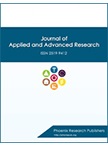A comprehensive review on Nipah virus infection control measures
DOI:
https://doi.org/10.21839/jaar.2023.v8.8714Keywords:
Nipah virus, Zoonotic transmission, Diagnosis, Prevention, TreatmentAbstract
Nipah virus (NiV) has emerged as a deadly zoonotic pathogen, causing sporadic outbreaks with high mortality rates. The patient typically exhibits thrombocytopenia, leukopenia, and transaminitis along with fever, encephalitis, and/or respiratory involvement. This comprehensive review delves into the multifaceted realm of Nipah virus infection control measures. We explore the latest research, strategies, and practices aimed at preventing, containing, and mitigating the impact of NiV outbreaks. From surveillance and diagnosis to treatment and public health interventions, this review offers a holistic perspective on the ongoing efforts to combat this deadly virus.
Downloads
References
Chua, K. B. (2003). Nipah virus outbreak in Malaysia. Journal of Clinical Virology, 26(3), 265-275. https://doi.org/10.1016/s1386-6532(02)00268-8
Clayton, B. A., Middleton, D., Arkinstall, R., Frazer, L., Wang, L.-F., & Marsh, G. A. (2016). The nature of exposure drives transmission of Nipah viruses from Malaysia and Bangladesh in ferrets. PLOS Neglected Tropical Diseases, 10(6), e0004775. https://doi.org/10.1371/journal.pntd.0004775
Conroy, G. (2023). Nipah virus outbreak: What scientists know so far. Nature. https://doi.org/10.1038/d41586-023-02967-x
Harcourt, B. H., Lowe, L., Tamin, A., Yu, Z., Bankamp, B., Bowden, N., Rollin, P. E., Comer, J. A., Ksiazek, T. G., Hossain, M. J., Gurley, E. S., Breiman, R. F., Bellini, W. J., & Rota, P. A. (2005). Genetic characterization of Nipah virus, Bangladesh, 2004. Emerging Infectious Diseases, 11(10), 1594-1597. https://doi.org/10.3201/eid1110.050513
Hughes, J. M., Wilson, M. E., Luby, S. P., Gurley, E. S., & Hossain, M. J. (2009). Transmission of human infection with Nipah virus. Clinical Infectious Diseases, 49(11), 1743-1748. https://doi.org/10.1086/647951
Islam, M. S., Sazzad, H. M. S., Satter, S. M., Sultana, S., Hossain, M. J., Hasan, M., Rahman, M., Campbell, S., Cannon, D. L., Ströher, U., Daszak, P., Luby, S. P., & Gurley, E. S. (2016). Nipah virus transmission from bats to humans associated with drinking traditional liquor made from date palm sap, Bangladesh, 2011-2014. Emerging Infectious Diseases, 22(4), 664-670. https://doi.org/10.3201/eid2204.151747
Knipe, D., Howley, P., Griffin, D., Lamb, R., Martin, M., Roizman, B., & Straus, S. (2013). Fields virology, 1 and 2. Pennsylvania, US: Lippincott Williams & Wilkins.
Liu, J., Coffin, K. M., Johnston, S. C., Babka, A. M., Bell, T. M., Long, S. Y., Honko, A. N., Kuhn, J. H., & Zeng, X. (2019). Nipah virus persists in the brains of nonhuman primate survivors. JCI Insight, 4(14), e129629. https://doi.org/10.1172/jci.insight.129629
Nikolay, B., Salje, H., Hossain, M. J., Khan, A. K. M. D., Sazzad, H. M. S., Rahman, M., Daszak, P., Ströher, U., Pulliam, J. R. C., Kilpatrick, A. M., Nichol, S. T., Klena, J. D., Sultana, S., Afroj, S., Luby, S. P., Cauchemez, S., & Gurley, E. S. (2019). Transmission of Nipah virus - 14 years of investigations in Bangladesh. The New England Journal of Medicine, 380, 1804-1814. https://doi.org/10.1056/NEJMoa1805376
Pillai, V. S., Krishna, G., & Veettil, M. V. (2020). Nipah virus: Past outbreaks and future containment. Viruses, 12(4), 465. https://doi.org/10.3390/v12040465
Rahman, M. T., Sobur, M. A., Islam, M. S., Ievy, S., Hossain, M. J., El Zowalaty, M. E., Rahman, A. T., & Ashour, H. M. (2020). Zoonotic diseases: Etiology, impact, and control. Microorganisms, 8(9), 1405. https://doi.org/10.3390/microorganisms8091405
Sharma, V., Kaushik, S., Kumar, R., Yadav, J. P., & Kaushik, S. (2019). Emerging trends of Nipah virus: A review. Reviews in Medical Virology, 29(1), e2010. https://doi.org/10.1002/rmv.2010
Tiong, V., Shu, M.-H., Wong, W. F., AbuBakar, S., & Chang, L.-Y. (2018). Nipah virus infection of immature dendritic cells increases its transendothelial migration across human brain microvascular endothelial cells. Frontiers in Microbiology, 9, 2747. https://doi.org/10.3389/fmicb.2018.02747
WHO. (2018a). World Health Organization. Outbreak of Nipah virus encephalitis in the Kerala state of India.
WHO. (2018b). World Health Organization. Nipah virus. Retrieved from https://www.who.int/news-room/fact-sheets/detail/nipah-virus
Xu, K., Rajashankar, K. R., Chan, Y.-P., Himanen, J. P., Broder, C. C., & Nikolov, D. B. (2008). Green version. Proceedings of the National Academy of Sciences of the United States of America, 105(29), 9953-9958. https://doi.org/10.1073/pnas.0804797105
Yob, J. M., Field, H., Rashdi, A. M., Morrissy, C., van der Heide, B., & Rota, P., bin Adzhar, A., White, J., Daniels, P., Jamaluddin, A., & Ksiazek, T. (2001). Nipah virus infection in bats (order Chiroptera) in peninsular Malaysia. Emerging Infectious Diseases, 7(3), 439-441. https://doi.org/10.3201/eid0703.010312





 .
.